Castanet lock in Castanet-Tolosan - the first oval-shaped lock
on the Canal du Midi
As the first elliptical basin between Toulouse and the Mediterranean Sea, Castanet lock is yet another example of Riquet's ingenuity. This unique oval shape is characteristic of the Canal du Midi because all the locks were subsequently built according to this first model.
Castanet lock is a masterpiece and a technical feat
The first elliptical basin between Toulouse and Sète
Castanet lock, in the town of Castanet-Tolosan, is the first elliptical basin you will come to after leaving Toulouse and heading towards Sète.
Castanet lock was built in 1668, and is 15.7 km from Toulouse. It is 152 metres above sea level, and the departure of the canal at the Port de l’Embouchure in Toulouse is 132 metres above sea level.
After the construction of Castanet lock, all the Canal du Midi locks were built in this distinctive oval shape!
Did you know?
Castanet lock originally featured two chambers (basins), but only one was retained after the modernisation work in 1978-1979 when all lock chambers were extended by 10 metres, to allow for the passage of a 38.5-metre-long barge, in accordance with the Freycinet gauge.
New types of locks
The first locks built in Toulouse by Pierre Paul Riquet were locks with straight walls. But in the early stages of construction, Riquet noticed a distortion in the side wall of a lock due to extreme pressure from the earth around the lock, and so he modified his design for the Canal du Midi locks.
For Castanet lock, Riquet opted for an elliptical shape. This meant that the load was better distributed across the lock walls and so the structure was more solid.
These elliptical locks were built according to a strict typology: 11 metres in width at the centre, 6 metres at the gates, and 30.5 metres in length. To make it easier to open and close the lock gates, Riquet also limited the maximum height to 2.9 metres.
The deeper the locks, the bigger the gates and the more difficult it would be to open and close them. The gates were initially made from oak and were opened using a rocker arm system.
In opting for less significant depths, Riquet made the lock keeper's job easier. These new constructions therefore then led to the creation of intermediate lock chambers, and the invention of double, triple locks or even more.
A waterfall and a mill
By construction decree of 1666, Pierre-Paul Riquet was authorised to build mills at some locks. With two adjoining basins, Castanet lock has a height difference of close to 5 metres, which is the perfect height to turn a millstone! The location was also ideal, with wheat arriving by boat from the Lauragais, and close to a major flour consumption zone. The mill was built at the same time as the lock and then put into operation in 1674. It was used up until the end of the 19th century. The building was then destroyed when the lock was modernised in the late 1970s.
Boost the declining navigation
Modernisation work
A law was voted on 5 August 1879 to align the locks with the Freycinet gauge. The goal was to boost navigation due to fierce competition from road and rail transport.
The original idea was to align all the Canal du Midi locks with this new gauge. But the work was only actually carried out on a handful of locks at either end of the Canal du Midi, as the project was dropped. It was not as successful as people had hoped!
A new appearance for Castanet lock
As part of this project, the oval-shaped Castanet lock was extended with a straight lock wall in 1978. After this work, the lock chamber was 39 m long and 5.5 m wide so that 300 or 350-tonne barges could pass through, with a draught of 1.80 m to 2.20 m.
A pleasant place to visit near Toulouse
Castanet lock and the aqueduct
Castanet lock and the lock keeper's house have both been listed as Historic Monuments since 1998.
Likewise, Castanet aqueduct where the Lacande or Castanet stream flows is also listed as a Historic Monument. This aqueduct was designed by Vauban and built by D. Gillade from 1687 to 1689. You can still see traces of its partial reconstruction in the 18th century.
Did you know?
On the right banks, you'll see the former lock keeper's house, the basement of which was partly used for stables. On the other side, you'll be able to make out the foundations of the ancient mill built by Riquet in 1674. This site suffered when the lock was extended in 1978.
The town of Castanet-Tolosan
There is a restaurant here called 'L'Ecluse de Castanet'. You can eat too at the restaurant inside Vic lock keeper's house nearby.
The town of Castanet-Tolosan is a very pleasant place to stop, with parks, children's play areas and many shops. There is a car park near the Canal du Midi which is the perfect departure point for a walk.













